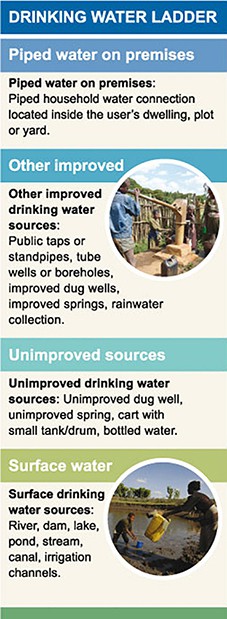Types of water source
In Study Session 1 you were introduced to the three main sources of water: groundwater, surface water and rainwater. In arid regions where seawater is accessible (such as in the Middle East), desalination (the removal of salts from water) is used to generate drinking water. Another potential source of water is treated wastewater – you will learn more about this in Study Session 11. In practice, the term ‘water source’ can be used to mean both the origin of the water and also the place where people get their water (spring, piped supply to household tap, water point, well, etc.).
Water sources can be classified as protected or unprotected. Protected sources are covered by stonework, concrete or other materials that prevent the entry of physical, chemical and biological contaminants. Typical characteristics of a protected water source are given in Box 3.1.
Box 3.1 Characteristics of a protected water source
- The water source is fully enclosed or capped and no surface water can run directly into it.
- People do not step into the water while collecting it.
- Latrines, solid waste pits, animal excreta and other sources of pollution are located as far away as possible from the water source and on ground lower in elevation than the water source.
- There is no stagnant water within 5 metres of the water source.
- The water collection buckets or hand pump at the source are kept clean.
Why do you think there should be no stagnant water within 5 metres of a water source?
It could encourage animals to come there for water, and they could contaminate the water source. Stagnant water can also become a breeding site for mosquitoes.
Unprotected sources are those with no barrier or other structure to protect the water from contamination. All surface water sources, such as lakes, rivers and streams or poorly constructed wells, are examples of unprotected sources. Water from unprotected sources cannot be considered safe to drink unless it has been treated.
The terms ‘improved’ and ‘unimproved’ are also used to describe water sources and are broadly equivalent to ‘protected’ and ‘unprotected’. WHO /UNICEF categories of water sources are defined in this way, as you can see in Figure 3.1. This shows the drinking water ladder, which describes the steps in improvement of quality of water supply depending on the type of source. Surface water is at the bottom of the ladder and piped water into the household is at the top. There are a number of improved and unimproved sources between these two, several of which are described in later sections of this study session.

Figure 3.1 Drinking water ladder.